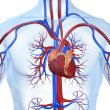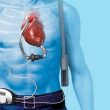Performing a successful primary angioplasty and prescribing preventive medication without advising on the importance of keeping up with or taking up physical activity is a waste of one of our many opportunities to improve the quality of life of our patients and reduce mortality among them. If clinical cardiologists do not take over the patient,...
CTO in patients with acute myocardial infarction increases long term mortality
Courtesy of Dr. Carlos Fava. It has been proved that in a setting of acute myocardial infarction with multivessel lesions, only the culprit vessel must be treated (if there is no hemodynamic compromise) at first, and other severe lesions are to be treated during a second session. However, proper conduct in cases with presence of chronic...
Mortality at one year in post PCI myocardial infarction
Courtesy of Dr. Brian Nazareth Donato. Multiple definitions with biomarkers and variable thresholds have been proposed to diagnose post procedural MI. The last update of the Third Universal Definition of Myocardial Infarction decided to use only troponin values with a threshold >5 over the normal value, on top of the clinical evidence by ECG, echocardiography...
Ventricular Assist Device in Acute Myocardial Infarction
Original Title: Ventricular Assist Device in Acute Myocardial Infarction. Reference: Deepak Acharya et al. J Am Coll Cardiol. 2016;67(16):1871-1880. Patients undergoing acute myocardial infarction (AMI) with acute cardiac failure or cardiogenic shock have a high mortality rate with the conventional treatment. This study assessed the outcomes of patients with AMI receiving a durable ventricular assist...
Survivors of Myocardial Infarction with Cardiogenic Shock: Long Term Outcomes.
Título original: Post-Hospital Outcomes of Patients With Acute Myocardial Infarction With Cardiogenic Shock Findings From the NCDR. Referencia: Rashmee U. Shah et al. J Am Coll Cardiol. 2016;67(7):739-747. Even though mortality after cardiogenic shock MI is quite high, many survive and are discharged. So far, there is little we know about their prognosis after discharge....
Immediate vs. delayed intervention in non-ST-elevation myocardial infarction
Original Title: Immediate Versus Delayed Invasive Intervention for Non-ST-Segment Elevation Myocardial Infarction Patients The RIDDLE-NSTEMI Study (Randomized study of ImmeDiate versus DeLayedinvasivE intervention in patients with Non-ST-segment Elevation Myocardial Infarction). Reference: J Am CollCardiolIntv. 2016. Online before print. This study assessed the clinical impact of immediate invasive intervention (within 2 hours) vs. delayed intervention (within...
FFR in non-ST elevation myocardial infarction
Original Title: Fractional flow reserve vs. angiography in guiding management to optimize outcomes in non-St segment elevation myocardial infarction: the British Heart Foundation FAMOUS–NSTEMI randomized trial. Reference: Jamie Layland et al. European Heart Journal (2015) 36, 100–111 Courtesy of Dr. José Amadeo Guillermo Álvarez. Several studies have established the value of fractional flow reserve (FFR) in...
NONSTEMI: Superiority of early angioplasty in non-ST elevation myocardial infarction
The European guidelines recommend revascularization within 24 hours in high-risk patients with No ST segment elevation myocardial infarction. It is unclear whether these patients would benefit from an immediate strategy. This randomized, open, and controlled study included 250 patients with suspected Non ST segment elevation myocardial infarction. Patients were randomized to early coronary angiography or...
BVS-STEMI-FIRST OCT study: Bioabsorbable platform in acute myocardial infarction
A bioabsorbable platform implant in the context of ST segment elevation acute myocardial infarction is feasible although the subsequent cicatrization of the artery is not documented. The objective of this work was to evaluate optical coherence tomography (OCT) in patients who received everolimus-releasing bioabsorbable platform in the context of primary angioplasty. A total of 39...









